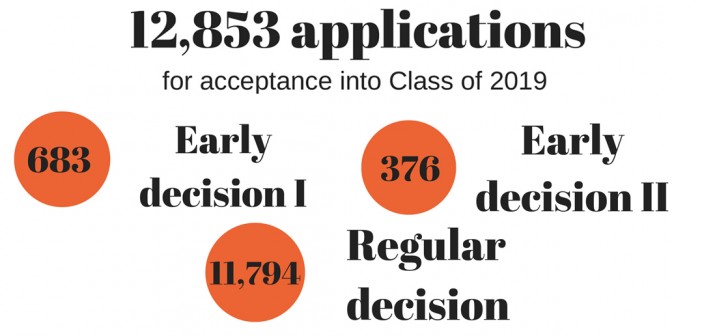According to a recent U.S. News & World Report ranking, Lehigh University was categorized as a “more selective” university when it came to its admissions process. Approximately 30 percent of those who applied to attend Lehigh in the fall of 2013 were accepted.
In 2013, The Philadelphia Inquirer observed Lehigh’s admissions process. Following that, The Brown and White spent four hours observing an admissions committee session March 6.
This year, Lehigh received 12,853 applications from prospective students. Of those applications, 683 were Early Decision I applications, 376 were Early Decision II and 11,794 were regular decision. Early decision applications, which have an earlier deadline than regular decision applications, are binding, meaning that if a student applies early decision to a university, and the university accepts him or her, the student must attend that school.
When applications are received by Lehigh, they are reviewed by admissions counselors. Bruce Bunnick, the director of admissions, said an applicant goes to the admissions committee only when two counselors who read the same application come to different conclusions.
The admissions committee, which consists of a group of admissions counselors discussing specific applicants and voting, only deals with about 80 applicants.
Bunnick and J. Leon Washington, the vice provost for admissions and financial aid, both said the task for the committee is to bring in a well-rounded class with the right mix of diversity in gender, race, geography and first-generation status, among other factors. The committee also works to maintain an appropriate yield, or percentage of accepted students who enroll, that will maintain Lehigh’s status as a selective institution. It also has to be sure to avoid an enrollment problem, such as what happened with the Class of 2018, when more students than anticipated enrolled in the university.
“With the increase in applications, it makes the task of reviewing all these wonderfully qualified students even more challenging and difficult,” Bunnick said.
Bunnick and Washington said they allowed The Brown and White and The Inquirer to sit in on the process with the hopes to debunk the myths of the process being ‘mechanical’ and only concerned with numbers. Rather, they want people to see that the admissions process takes into account everything a candidate brings to the table.
“I really want everyone who thinks of highly selective admission to really see that we are concerned about the person,” Washington said. “It’s a very personal process, we’re looking for things like what’s the fit, what will a student bring, those things are very important to us. But at the same time, its not just about number. It really is a human process.”
Sarah Bombard, ’06, ’08G, an admissions counselor, described an experience she had with a prospective student that highlighted Washington’s point about the admissions process being personal.
Bombard interviewed the prospective student, who was from the Midwest and was interested in the Integrated Degree in Engineering, Arts, and Sciences program, and said that although the student was very shy before his interview, he was enthusiastic about enrolling in the program at Lehigh.
Bombard also said the student consistently interacted with Lehigh individuals — including attending Bombard’s visit to his high school — throughout his admissions process. The committee unanimously voted to offer him admission to the university.
Extracurricular activities are also an important factor considered during the admissions process. One male student from Florida was admitted to Lehigh in part due to his good leadership qualities, which were exemplified through the small business he runs.
The admissions process also puts emphasis on an applicant’s essay. While there are many applicants for whom a good essay with a compelling message plays a large factor in their admission to Lehigh, some essays can hurt applicants.
For example, one student applying to the P.C. Rossin College of Engineering and Applied Sciences, who was highly ranked in his high school class, said in his essay that he liked the “work hard, play hard” atmosphere at Lehigh. While the admissions committee liked the sentiment behind the statement, the members were clearly concerned with the way in which it was phrased.
Admissions counselor Beth Guzzo,’11,’13G, said it would have been more appropriate for the prospective student to write something along the lines of, “Not only access to great academics, but also opportunities to participate outside of the classroom.” In addition, while his grades and SAT scores certainly were respectable, she said there really was nothing significantly compelling to offer in his profile. Seven committee members voted to place the student on the wait list, and six voted to admit him.
Many students also believe that being a legacy of Lehigh highly increases a candidate’s chances of being admitted to the school. However, according to the admissions committee, being a legacy is not a guarantee of admission.
“We tell our legacy families that, all things being equal, if a student is absolutely prepared to be at Lehigh, and is competitive in the pool in a given year, then that legacy is a hook, not a guarantee, but a hook,” Washington said.
One prospective female student who had several family members graduate from Lehigh, including a parent, was initially deferred after applying early decision. Her application was in review again during the session, but she was ultimately placed on the wait list because the committee saw no real change in her overall academic profile. The final tally was 10 votes for the wait list, four to deny and one to offer admission.
A big factor in maintaining a good yield percentage is to offer admission to students who counselors feel are likely to accept an offer of admission to Lehigh. This sometimes means placing applicants on the wait list, even though they have strong credentials, because they have shown limited interest.
Students initially showing limited interest, however, do not always follow the predicted pattern. One student now enrolled in the Class of 2018 boasted a perfect score on the verbal and math sections of the SAT. Originally he was placed on the wait list, but chose to attend Lehigh after ultimately being accepted.
An applicant from an affluent New York City suburban public school — from which eight students have already accepted offers of admission to attend Lehigh next fall — was placed on the wait list despite excellent grades and standardized test scores because the admissions department predicted it was unlikely that he would choose to attend the university.
The admissions office makes it a priority to maintain relationships with geographic areas that have proved fertile, as well as “feeder schools,” which typically generate at least 20 applicants in a given year.
An example of this dilemma from the session was a prospective student from a key market for Lehigh admissions, who was valedictorian of her class with a competitive ACT score. Many of the counselors wanted to put the applicant on the wait list because they were concerned she would not attend. The committee deliberated and the result was eight votes to place the student on the wait list, and eight wanting to offer admission to the university.
In this situation, Washington broke the tie by voting to admit the prospective student. He wanted to preserve the relationship in an area that tends to produce many future Lehigh students. He said he thought admitting students with very good standardized test scores, but not extraordinary scores would send a message that would discourage qualified students from applying, and high school counselors from encouraging them from doing so.
Prospective students will continue to receive admission decisions until the end of the month.






Comment policy
Comments posted to The Brown and White website are reviewed by a moderator before being approved. Incendiary speech or harassing language, including comments targeted at individuals, may be deemed unacceptable and not published. Spam and other soliciting will also be declined.
The Brown and White also reserves the right to not publish entirely anonymous comments.